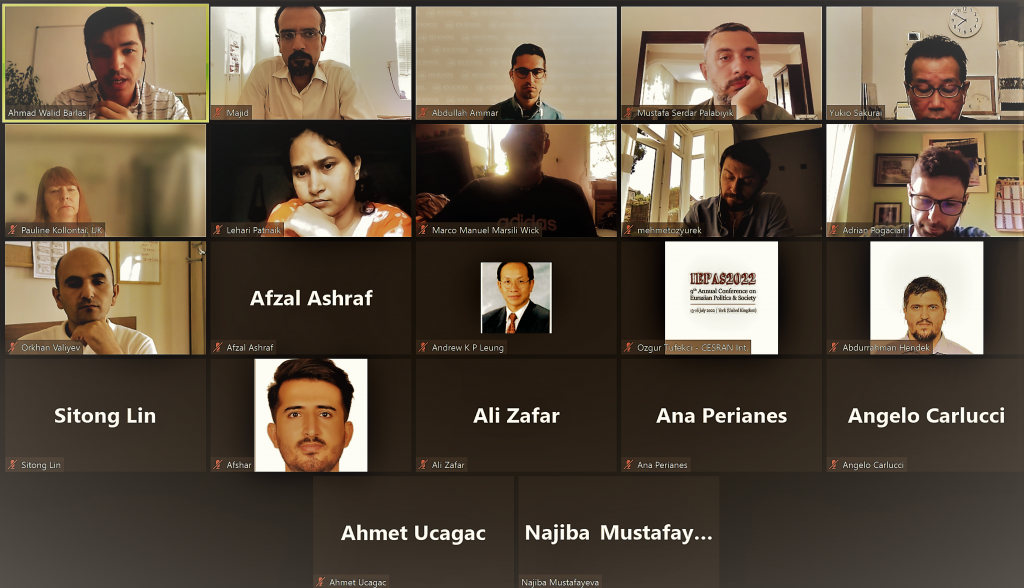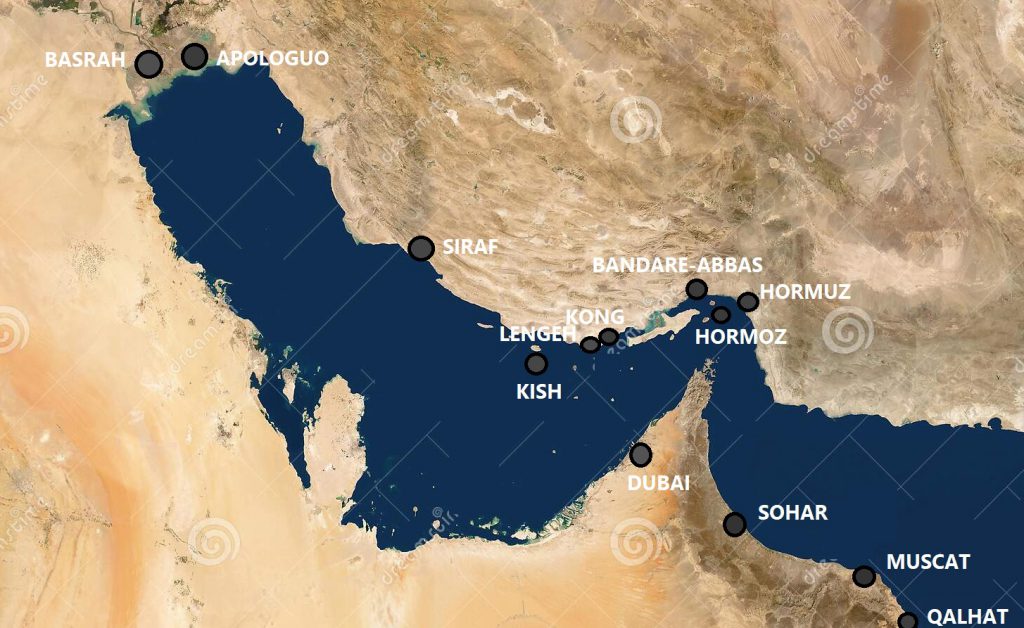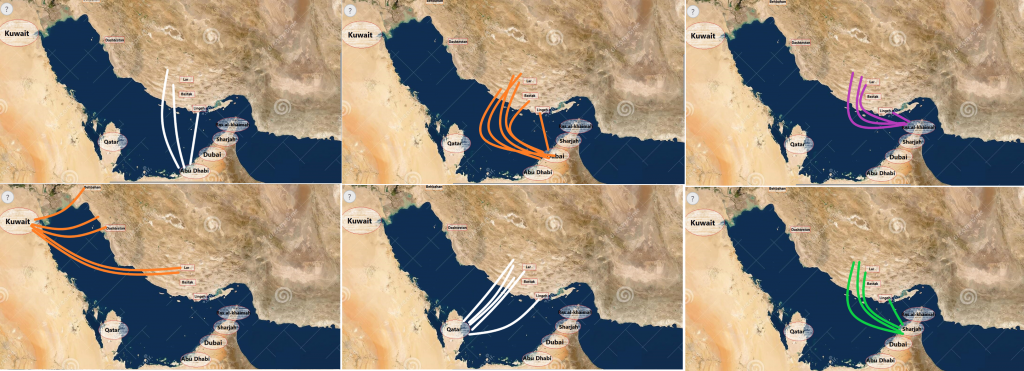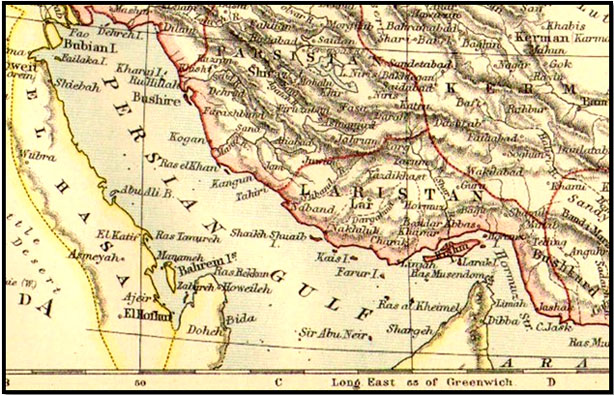
Iranian immigration channels to GCC countries during the last hundred years
Throughout history, Iranians have migrated less widely to other parts of the world. Perhaps, the vastness of the land of Pars caused most of the migrations to be internal.
However, the migration of the people in southern Iran to the countries of the Persian Gulf Cooperation Council, abbreviated as GCC, is unique, in terms of extent and type. In my presentation, I’ll try to briefly explain the impact of significant social, political and economic events on this migration corridor.
Immigration centers in the COASTS OF Persian Gulf AND OMAN SEA throughout history
At first, I will try to give you a brief overview of the main commercial centers of this region throughout history:
The first port was Apologuo related to Ancient Persia/ After that, Basra since 7th century/ then Siraf between 9th and 11th century and, the Sohar in Oman as a complementary port/ Then traders migrated to Kish/ port of Hormuz became important since late 11th century and besides Qalhat as the alternative port/ Muscat replaced these ports in the 16th century/ Bandar Abbas and also Kong prospered since 17th century/ At the beginning of the 18th century Muscat /and in the middle of the 19th century, Lengeh became important.

From here on, I will examine more closely the events that affect this migration corridor
The decline of Lengeh and the shining of Dubai
Since the beginning of the 20th century the Qajar Kingdom changed the customs tariff law. So, merchants of Lengeh had to pay sums. Thus, so many of them decided to migrate to Dubai, and this was the beginning of the formation of the commercial port of Dubai.
A different area
Undoubtedly, these movements of traders over the centuries have made a kind of cultural combination. According to researchers, people in this area are very similar in terms of culture and it distinguishes them from other parts of the Middle East.

In the following, you can see the main destinations of the pioneer Iranian immigrants in some of GCC countries.

As you see the first migrants were mostly from this region which is historically and culturally called Larestan. / and nowadays this region has been divided in 3 different provinces: Bushehr, Fars and Hormozgan

Persian constitutional revolution, 1905-1911
In 1908, the formation of the constitutionalism movement in the region of Larestan led to severe insecurity in the south of Iran; Therefore, it intensified the flow of merchants and capitalists’ emigration from this region.
World War I,1914
The presence of warring forces in Iran, the occurrence of famine, poverty and the spread of infectious diseases, greatly increased the scope of southerners’ migration to GCC countries.
Unveiling
Another large wave of migration occurred in the 1930s in response to Reza Shah Pahlavi’s policies, especially the law on women’s hijab removal had a great role in migrations of southerner’s families.
The profession of Larestani immigrant before World War II
Some immigrants say that the main occupation of Larestanies was fishing and pearling until the Second World War. They even used to prepare essential items such rice, sugar, coffee, oil and date for Arab sheikhs.
World War II, 1939
The Second World War and the outbreak of famine in Iran caused the forced migration of southerners to Arab countries. One of the residents of Gerash says: Famine had engulfed the country. For us who lived in the south of Iran, the only place to escape from hunger was Dubai.
The nationalization of the oil industry and the migration of Iranians to Kuwait, 1950s
After this event and the relocation of the British company from Abadan Oil Company to Kuwait, many Iranians who worked in Abadan (a city in southwest of Iran) also moved to that country.
Older expats remember the British’s discipline and honesty and their commitment to the workforce. These old immigrants are very organized and owe this trait to the British. But interestingly, they are happy that the British left Iran and they always remember Dr. Mossadegh, the leader of the oil nationalization movement, as a national hero.
۱۹۶۰s; the beginning of oil extraction
In the 1960s and with the start of oil extraction in Arab countries, the people of Larestan and some of other southerners opened small stores in order to provide food for migrant workers in the oil and construction industry.
Over the years, the Arabs became aware of the intelligence, commitment and humanity of the southerners, and made them share in their income. They also were able to obtain permanent residence permit and be considered citizens of that country, and eventually they could hold important political and administrative positions.
Rising oil prices, early 1970s
The unprecedented increase in the price of oil caused the wealth of the GCC countries to grow dramatically. The southerners also benefited from this issue; The small shops expanded to large stores and their limited businesses changed to enormous trades throughout the Middle East and the world.
Hope after Iranian Islamic Revolution of 1979
Some southerners say that after the revolution, a large population of immigrants, who had migrated to Arab countries due to the hijab ban during Reza Khan’s era, returned to Iran hoping better life.
Depreciation of the Iranian rial after the revolution
With the Islamic revolution in 1979, Iran’s economy underwent drastic changes and fluctuations. From then until now the value of IR Real decreased 4000 times. This would increase southerners’ income in GCC countries and naturally increased the desire of southerners to emigrate.
Early 1990s; Beginning of immigration of non-southern Iranians
After the end of Iraq war against Iran, domestic investors were not hopeful about the future investment and economic status of the country, so the migration of non-southerners to GCC began as well. Especially from big cities. Now we have two types of Iranians: southerners that they have a lot in common with GCC people and non-southerners.
۱۹۹۰ Iraqi Invasion of Kuwait
After Iraq’s attack on Kuwait, not only Iranian immigrants but also many Kuwaitis first came to the UAE and then became refugees in Iran.
After the departure of the Iraqis from Kuwait, the Kuwaiti government, wisely, made many economic concessions. This is why Kuwaitis and many immigrants, such as Iranians, returned to Kuwait.
Ahmadinejad’s presidency, 2012
Ahmadinejad’s presidency is one of the most important eras of Iranian migration to Arab countries. After his baseless talk regarding the presence of Iranian security forces in the UAE, the Arab countries’ policy towards Iranians changed. From then on, the plan to expel Iranian workers and put pressure on Iranian businessmen started. Currently, Iranians still have challenges to work, invest and remittance in all GCC countries.
Bahrain and the Arab Spring, 2011
The emergence of protests in Bahrain and the increase of suspicions towards Iran led to the purge of Iranian immigrants from this country.
Conclusion
It is necessary to carry out in-depth research and field studies regarding the social relations in this area, so that the policy makers become more aware of the importance of these relations and interactions. In addition, governments can take advantage of these deep and long-standing relations in the field of economy and international relations.